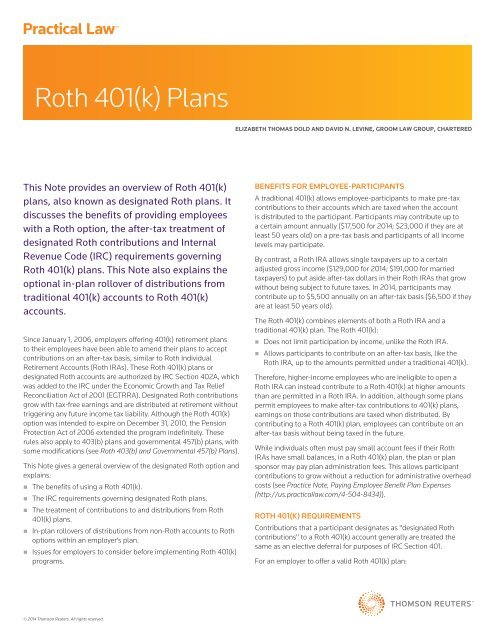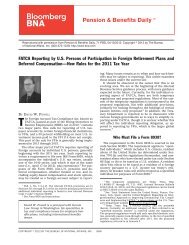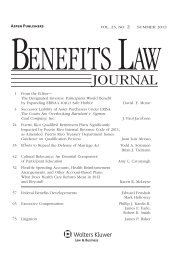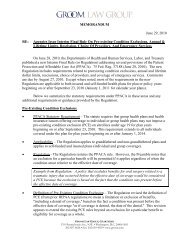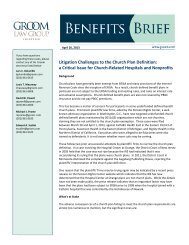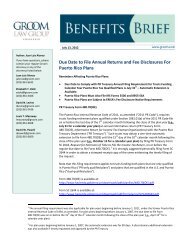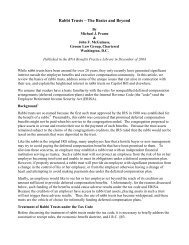Roth 401(k) Plans (PDF) - Groom Law Group
Roth 401(k) Plans (PDF) - Groom Law Group
Roth 401(k) Plans (PDF) - Groom Law Group
You also want an ePaper? Increase the reach of your titles
YUMPU automatically turns print PDFs into web optimized ePapers that Google loves.
<strong>Roth</strong> <strong>401</strong>(k) <strong>Plans</strong><br />
ELIZABETH THOMAS DOLD AND DAVID N. LEVINE, GROOM LAW GROUP, CHARTERED<br />
This Note provides an overview of <strong>Roth</strong> <strong>401</strong>(k)<br />
plans, also known as designated <strong>Roth</strong> plans. It<br />
discusses the benefits of providing employees<br />
with a <strong>Roth</strong> option, the after-tax treatment of<br />
designated <strong>Roth</strong> contributions and Internal<br />
Revenue Code (IRC) requirements governing<br />
<strong>Roth</strong> <strong>401</strong>(k) plans. This Note also explains the<br />
optional in-plan rollover of distributions from<br />
traditional <strong>401</strong>(k) accounts to <strong>Roth</strong> <strong>401</strong>(k)<br />
accounts.<br />
Since January 1, 2006, employers offering <strong>401</strong>(k) retirement plans<br />
to their employees have been able to amend their plans to accept<br />
contributions on an after-tax basis, similar to <strong>Roth</strong> Individual<br />
Retirement Accounts (<strong>Roth</strong> IRAs). These <strong>Roth</strong> <strong>401</strong>(k) plans or<br />
designated <strong>Roth</strong> accounts are authorized by IRC Section 402A, which<br />
was added to the IRC under the Economic Growth and Tax Relief<br />
Reconciliation Act of 2001 (EGTRRA). Designated <strong>Roth</strong> contributions<br />
grow with tax-free earnings and are distributed at retirement without<br />
triggering any future income tax liability. Although the <strong>Roth</strong> <strong>401</strong>(k)<br />
option was intended to expire on December 31, 2010, the Pension<br />
Protection Act of 2006 extended the program indefinitely. These<br />
rules also apply to 403(b) plans and governmental 457(b) plans, with<br />
some modifications (see <strong>Roth</strong> 403(b) and Governmental 457(b) <strong>Plans</strong>).<br />
This Note gives a general overview of the designated <strong>Roth</strong> option and<br />
explains:<br />
• The benefits of using a <strong>Roth</strong> <strong>401</strong>(k).<br />
• The IRC requirements governing designated <strong>Roth</strong> plans.<br />
• The treatment of contributions to and distributions from <strong>Roth</strong><br />
<strong>401</strong>(k) plans.<br />
• In-plan rollovers of distributions from non-<strong>Roth</strong> accounts to <strong>Roth</strong><br />
options within an employer's plan.<br />
• Issues for employers to consider before implementing <strong>Roth</strong> <strong>401</strong>(k)<br />
programs.<br />
BENEFITS FOR EMPLOYEE-PARTICIPANTS<br />
A traditional <strong>401</strong>(k) allows employee-participants to make pre-tax<br />
contributions to their accounts which are taxed when the account<br />
is distributed to the participant. Participants may contribute up to<br />
a certain amount annually ($17,500 for 2014; $23,000 if they are at<br />
least 50 years old) on a pre-tax basis and participants of all income<br />
levels may participate.<br />
By contrast, a <strong>Roth</strong> IRA allows single taxpayers up to a certain<br />
adjusted gross income ($129,000 for 2014; $191,000 for married<br />
taxpayers) to put aside after-tax dollars in their <strong>Roth</strong> IRAs that grow<br />
without being subject to future taxes. In 2014, participants may<br />
contribute up to $5,500 annually on an after-tax basis ($6,500 if they<br />
are at least 50 years old).<br />
The <strong>Roth</strong> <strong>401</strong>(k) combines elements of both a <strong>Roth</strong> IRA and a<br />
traditional <strong>401</strong>(k) plan. The <strong>Roth</strong> <strong>401</strong>(k):<br />
• Does not limit participation by income, unlike the <strong>Roth</strong> IRA.<br />
• Allows participants to contribute on an after-tax basis, like the<br />
<strong>Roth</strong> IRA, up to the amounts permitted under a traditional <strong>401</strong>(k).<br />
Therefore, higher-income employees who are ineligible to open a<br />
<strong>Roth</strong> IRA can instead contribute to a <strong>Roth</strong> <strong>401</strong>(k) at higher amounts<br />
than are permitted in a <strong>Roth</strong> IRA. In addition, although some plans<br />
permit employees to make after-tax contributions to <strong>401</strong>(k) plans,<br />
earnings on those contributions are taxed when distributed. By<br />
contributing to a <strong>Roth</strong> <strong>401</strong>(k) plan, employees can contribute on an<br />
after-tax basis without being taxed in the future.<br />
While individuals often must pay small account fees if their <strong>Roth</strong><br />
IRAs have small balances, in a <strong>Roth</strong> <strong>401</strong>(k) plan, the plan or plan<br />
sponsor may pay plan administration fees. This allows participant<br />
contributions to grow without a reduction for administrative overhead<br />
costs (see Practice Note, Paying Employee Benefit Plan Expenses<br />
(http://us.practicallaw.com/4-504-8434)).<br />
ROTH <strong>401</strong>(K) REQUIREMENTS<br />
Contributions that a participant designates as "designated <strong>Roth</strong><br />
contributions" to a <strong>Roth</strong> <strong>401</strong>(k) account generally are treated the<br />
same as an elective deferral for purposes of IRC Section <strong>401</strong>.<br />
For an employer to offer a valid <strong>Roth</strong> <strong>401</strong>(k) plan:<br />
© 2014 Thomson Reuters. All rights reserved.
<strong>Roth</strong> <strong>401</strong>(k) <strong>Plans</strong><br />
• The employer must also offer a traditional <strong>401</strong>(k) plan. Designated<br />
<strong>Roth</strong> accounts cannot exist without an accompanying pre-tax<br />
elective deferral plan.<br />
• Participants must be able to designate some or all of their elective<br />
deferrals as <strong>Roth</strong> <strong>401</strong>(k) contributions (see Treating Elective<br />
Deferrals as <strong>Roth</strong> <strong>401</strong>(k) Contributions).<br />
• The employer must include designated <strong>Roth</strong> contributions in the<br />
employee's gross income (IRC § 402A(a)(1)).<br />
• <strong>Roth</strong> contributions must be tracked and their records kept in<br />
a separate account, with any applicable earnings and losses<br />
allocated to that <strong>Roth</strong> account (see Separate Accounting for <strong>Roth</strong><br />
<strong>401</strong>(k) Accounts).<br />
TREATING ELECTIVE DEFERRALS AS ROTH <strong>401</strong>(K)<br />
CONTRIBUTIONS<br />
Participants must designate their contributions as <strong>Roth</strong> <strong>401</strong>(k)<br />
contributions at the time of the cash or deferred election (Treas. Reg.<br />
§ 1.<strong>401</strong>(k)-1(f)(1)(i)). <strong>Roth</strong> contributions are treated as elective deferrals<br />
under IRC Section 402(g)(3) and are subject to the same annual<br />
maximum limits as elective deferrals made to a traditional <strong>401</strong>(k)<br />
($17,500 for 2014 for participants under 50 years old) (IRC § 402A(a)<br />
(1), (c)(2) and Treas. Reg. § 1.<strong>401</strong>(k)-1(f)(4)).<br />
Because <strong>Roth</strong> contributions are treated as elective deferrals, the<br />
following rules apply:<br />
• Participants may contribute to both a <strong>Roth</strong> and a traditional<br />
<strong>401</strong>(k), but both contributions together are subject to the limits<br />
under IRC Section 402(g).<br />
• <strong>Plans</strong> may allow participants aged 50 and over to make additional<br />
elective deferral contributions or "catch-up contributions." These<br />
participants may make catch-up contributions as <strong>Roth</strong> <strong>401</strong>(k)<br />
contributions under the same restrictions as traditional <strong>401</strong>(k)<br />
catch-up contributions (IRC § 414(v)(1), (5)). For 2014, participants<br />
may contribute up to $5,500 over the annual contribution limit of<br />
$17,500, up to a total of $23,000.<br />
In addition:<br />
• Recharacterizations are not allowed. Once a participant has<br />
designated an elective deferral as a <strong>Roth</strong> <strong>401</strong>(k) contribution,<br />
the contribution is irrevocably a <strong>Roth</strong> contribution (Treas. Reg. §<br />
1.<strong>401</strong>(k)-1(f)(1)(i)).<br />
• Participants must be allowed to change their contributions for<br />
future contributions at least once per year (Treas. Reg. § 1.<strong>401</strong>(k)-1(f)<br />
(5)(i)).<br />
• Employees who become participants in a <strong>401</strong>(k) plan through<br />
automatic enrollment may be automatically enrolled in a <strong>Roth</strong><br />
<strong>401</strong>(k) rather than a traditional <strong>401</strong>(k) plan. Plan documents must<br />
specify whether contributions made for those participants will be<br />
designated <strong>Roth</strong> or pre-tax contributions. If the plan defaults to<br />
<strong>Roth</strong> contributions, employees are deemed to have irrevocably<br />
designated their contributions as <strong>Roth</strong> if they have not made an<br />
affirmative election (Treas. Reg. § 1.<strong>401</strong>(k)-1(f)(5)(ii)).<br />
EMPLOYER CONTRIBUTIONS<br />
Employers may not make contributions to a designated <strong>Roth</strong><br />
account. Any employer contributions, such as matching or profitsharing<br />
contributions, must be treated as pre-tax contributions and<br />
added to the participant's pre-tax account. However, special rules<br />
apply for in-plan rollovers to a <strong>Roth</strong> account (see In-plan Rollovers).<br />
NONDISCRIMINATION RULES<br />
As with all deferred compensation plans qualified under the IRC for<br />
favorable tax treatment, <strong>Roth</strong> <strong>401</strong>(k) plans may not discriminate in<br />
favor of highly compensated employees (HCEs) (see Practice Note,<br />
Requirements for Qualified Retirement <strong>Plans</strong>: Nondiscrimination<br />
Rules (http://us.practicallaw.com/3-506-6895#a788432)). <strong>Roth</strong><br />
<strong>401</strong>(k) plans are therefore subject to the same nondiscrimination<br />
tests as traditional <strong>401</strong>(k) plans. For purposes of the Actual Deferral<br />
Percentage (ADP) test, <strong>Roth</strong> contributions are treated as elective<br />
deferrals (Treas. Reg. § 1.<strong>401</strong>(k)-1(f)(4)(i)). However, while <strong>Roth</strong><br />
contributions are made on an after-tax basis, they are not included<br />
with traditional after-tax contributions and therefore are not<br />
generally subject to the Actual Contribution Percentage (ACP) test.<br />
For an overview of the ADP and ACP tests, see Practice Note,<br />
Safe Harbor <strong>401</strong>(k) <strong>Plans</strong>: Overview and Planning Opportunities:<br />
Nondiscrimination Rules (http://us.practicallaw.com/9-501-<br />
1089#a851205).<br />
If a plan must reduce contributions by HCEs to meet the<br />
nondiscrimination requirements, the plan can either:<br />
• Specify whether <strong>Roth</strong> contributions or pre-tax contributions are<br />
returned to the participant first.<br />
• Authorize participants to elect which contributions are refunded<br />
on a participant-by-participant basis. If <strong>Roth</strong> contributions are<br />
refunded, only earnings on those <strong>Roth</strong> contributions will be taxed<br />
(Treas. Reg. §§ 1.<strong>401</strong>(k)-2(b)(1)(i), (2)(vi)(C) and 1.<strong>401</strong>(m)-2(b)(2)(vi)<br />
(C).)<br />
Finally, the <strong>Roth</strong> <strong>401</strong>(k) contribution feature is itself a benefit, right or<br />
feature that is subject to the nondiscrimination rules. <strong>Plans</strong> may not<br />
discriminate in favor of HCEs when offering the <strong>Roth</strong> option (Treas.<br />
Reg. § 1.<strong>401</strong>(k)-1(a)(4)(iv)(B)).<br />
SEPARATE ACCOUNTING FOR ROTH <strong>401</strong>(K) ACCOUNTS<br />
Plan sponsors offering a <strong>Roth</strong> <strong>401</strong>(k) option must maintain:<br />
• Separate accounts for each participant's <strong>Roth</strong> <strong>401</strong>(k) contributions<br />
and allocable earnings.<br />
• Separate recordkeeping for each participant's <strong>Roth</strong> and non-<strong>Roth</strong><br />
accounts.<br />
(IRC § 402A(b)(2).)<br />
<strong>Roth</strong> <strong>401</strong>(k) and traditional <strong>401</strong>(k) accounts must be charged and<br />
credited with gains, losses and other credits and charges on a<br />
reasonable and consistent basis (Treas. Reg. § 1.<strong>401</strong>(k)-1(f)(3)). This<br />
rule prevents plan sponsors from allocating expenses to tax-deferred<br />
accounts to maximize the value of after-tax <strong>Roth</strong> accounts.<br />
Although <strong>Roth</strong> contributions are elective deferrals, <strong>Roth</strong> <strong>401</strong>(k)<br />
accounts and traditional <strong>401</strong>(k) accounts are treated separately for:<br />
• The de minimis distributions rule, under which plans may provide<br />
that accounts with a balance of $200 or less may not be rolled<br />
over in a direct rollover (see Treas. Reg. § 1.<strong>401</strong>(a)(31)-1(A-11)).<br />
2<br />
© 2014 Thomson Reuters. All rights reserved.
<strong>Roth</strong> <strong>401</strong>(k) <strong>Plans</strong><br />
• Automatic rollover rules for mandatory distributions under IRC<br />
Section <strong>401</strong>(a)(31)(B) (Treas. Reg. § 1.<strong>401</strong>(k)-1(f)(4)(ii)). Under this<br />
rule, if a participant's account balance is between $1,000 and<br />
$5,000 and the participant does not affirmatively elect to receive<br />
a distribution in another manner permitted by the plan, the plan<br />
may roll over the involuntary distribution to an IRA established<br />
for the participant (see IRC § <strong>401</strong>(a)(31)(B) and Practice Note,<br />
Requirements for Qualified Retirement <strong>Plans</strong>: Basic Qualification<br />
Requirements (http://us.practicallaw.com/3-506-6895#a570836)).<br />
• Rules relating to the division of rollover distributions into separate<br />
plans (Treas. Reg. §§ 1.<strong>401</strong>(k)-1(f)(4)(ii) and 1.<strong>401</strong>(a)(31)-1(A-9 to A-11)).<br />
DISTRIBUTIONS FROM ROTH <strong>401</strong>(K) ACCOUNTS<br />
As with a traditional <strong>401</strong>(k) plan, participants may only receive<br />
distributions from their <strong>Roth</strong> <strong>401</strong>(k) accounts on (if permitted under<br />
the plan's terms):<br />
• Terminating employment.<br />
• Death.<br />
• Disability.<br />
• Reaching age 59½.<br />
• Determination of hardship.<br />
In addition, unlike the <strong>Roth</strong> IRA, <strong>Roth</strong> <strong>401</strong>(k) plans are subject to<br />
the IRC's minimum required distributions requirements during the<br />
participant's lifetime (see Treas. Reg. § 1.<strong>401</strong>(k)-1(f)(4), IRC § <strong>401</strong>(a)<br />
(9) and Practice Note, Requirements for Qualified Retirement <strong>Plans</strong>:<br />
Basic Qualification Requirements (http://us.practicallaw.com/3-506-<br />
6895#a570836)).<br />
The payment of an annuity contract from a <strong>Roth</strong> <strong>401</strong>(k) account is<br />
not considered a distribution. Only amounts paid from the annuity<br />
contract itself qualify as distributions (Treas. Reg. § 1.402A-1(A-14)).<br />
Distributions from <strong>Roth</strong> accounts are not aggregated with<br />
distributions from non-<strong>Roth</strong> accounts for the rules regarding annuity<br />
payments and the taxation of annuity payments under IRC Section<br />
72.<br />
Qualified Distributions<br />
Only "qualified distributions" from <strong>Roth</strong> <strong>401</strong>(k) accounts are tax-free.<br />
Qualified distributions:<br />
• Are made:<br />
• on or after the participant reaches age 59½;<br />
• on or after the participant's death; or<br />
• due to the participant's disability.<br />
• Cannot be made within five years of the participant's first<br />
designated <strong>Roth</strong> contribution to that plan or a predecessor plan<br />
(see Calculating the Five-year Participation Period).<br />
(IRC § 402A(d).)<br />
Qualified distributions to beneficiaries and alternate payees are also<br />
measured by the participant's age, death or disability status, unless<br />
the beneficiaries and alternate payees roll the distribution over to<br />
their own designated <strong>Roth</strong> accounts.<br />
Unlike the <strong>Roth</strong> IRA, a distribution to finance the first-time purchase<br />
of a home is not a qualified distribution (IRC § 402A(d)(2)(A)).<br />
© 2014 Thomson Reuters. All rights reserved.<br />
Calculating the Five-year Participation Period<br />
Generally an employee's five-year participation period is determined<br />
separately for each plan. The five-year participation period begins<br />
to run from the first day of the first taxable year that the participant<br />
made a contribution to the particular <strong>Roth</strong> <strong>401</strong>(k) account (IRC<br />
§ 402A(d)(2)(B)(i) and IRS Notice 2013-74(A-8)). If the participant<br />
previously established another designated <strong>Roth</strong> account and rolls the<br />
funds over to that account:<br />
• The five-year period begins to run from the date of the first<br />
contribution to the first designated <strong>Roth</strong> account.<br />
• For a direct rollover made from one plan to another, the plan<br />
making the rollover must, within 30 days of the rollover, either:<br />
• report the first year of the five-year period and the portion of the<br />
distribution that is investment in the contract to the new plan;<br />
or<br />
• provide a statement that the distribution is qualified.<br />
• For an indirect rollover, where the participant receives the<br />
distribution and has 60 days to roll it over, the plan making the<br />
rollover must, on request, provide the participant a statement that<br />
the distribution is qualified or report the portion of the distribution<br />
that is investment in the contract within 30 days of the request.<br />
(IRC § 402A(d)(2)(B)(ii) and Treas. Reg. § 1.402A-2(A-2).)<br />
This is different from <strong>Roth</strong> IRAs, which begin the five-year period<br />
from the date of the first contribution made to any <strong>Roth</strong> IRA, not<br />
necessarily the one into which the participant rolls funds over.<br />
Therefore, if a participant rolls a distribution from a <strong>Roth</strong> <strong>401</strong>(k)<br />
account to a <strong>Roth</strong> IRA, the period that the funds were in the <strong>Roth</strong><br />
<strong>401</strong>(k) account do not count towards the <strong>Roth</strong> IRA's five-year period.<br />
Some contributions do not start the five-year period, including:<br />
• Excess deferrals.<br />
• Excess contributions that a plan distributes to comply with<br />
the ADP test (see Nondiscrimination Rules and Practice Note,<br />
Safe Harbor <strong>401</strong>(k) <strong>Plans</strong>: Overview and Planning Opportunities:<br />
Nondiscrimination Rules (http://us.practicallaw.com/9-501-<br />
1089#a851205)).<br />
• Contributions returned to a participant as a permissible<br />
withdrawal from an eligible automatic contribution arrangement<br />
(see IRC § 414(w)).<br />
(Treas. Reg. § 1.402A-1(A-4)(a).)<br />
A reemployed veteran's designated <strong>Roth</strong> contributions are treated as<br />
made in the taxable year of qualified military service that the veteran<br />
designates as the year to which the contributions relate (Treas. Reg. §<br />
1.402A-1(A-4)(e)).<br />
Treatment of Non-qualified Distributions<br />
Non-qualified distributions include:<br />
• Distributions of excess deferrals under IRC Section 402(g)(2).<br />
• Distributions of excess contributions under IRC Section <strong>401</strong>(k)(8).<br />
• Distributions of excess aggregate contributions under IRC Section<br />
<strong>401</strong>(m)(8).<br />
• Income earned on these excess deferrals or contributions.<br />
3
<strong>Roth</strong> <strong>401</strong>(k) <strong>Plans</strong><br />
• Certain amounts not treated as eligible rollover distributions,<br />
including:<br />
4<br />
• loans treated as deemed distributions; and<br />
• dividends on employer securities, as described in IRC Section<br />
404(k).<br />
(IRC § 402A(d)(2) and Treas. Reg. § 1.402A-1(A-2), (A-11).)<br />
Non-qualified distributions are partially included in the participant's<br />
gross income if there are earnings in the participant's account.<br />
Distributions are treated as coming pro rata from:<br />
• Earnings.<br />
• Tax-free contribution (also known as basis).<br />
This is different from a <strong>Roth</strong> IRA, in which non-qualified distributions<br />
are treated as a tax-free return of basis up to the amount of the <strong>Roth</strong><br />
IRA contributions. A 10% penalty for early withdrawal may apply to<br />
the part of the distribution that is includible in gross income unless<br />
an exception in IRC Section 72(t) applies (Treas. Reg. § 1.402A-1(A-3)<br />
and IRS: Designated <strong>Roth</strong> Accounts - Distributions from Designated<br />
<strong>Roth</strong> Accounts).<br />
Hardship Distributions<br />
Hardship distributions are permitted under <strong>Roth</strong> <strong>401</strong>(k) plans under<br />
similar rules as apply to traditional <strong>401</strong>(k) plans (Treas. Reg. §<br />
1.<strong>401</strong>(k)-1(d)(3)). The amount of contributions available for a hardship<br />
distribution are determined by the participant's total elective<br />
contributions, <strong>Roth</strong> and non-<strong>Roth</strong>, not including earnings on those<br />
accounts.<br />
When distributed for hardship purposes, <strong>Roth</strong> contributions are<br />
treated as a pro rata return of basis and earnings. If a participant<br />
takes a hardship distribution out of a <strong>Roth</strong> <strong>401</strong>(k) within five years of<br />
the first contribution, the participant is taxed on the earnings portion<br />
of the hardship payout (see Calculating the Five-year Participation<br />
Period and Treatment of Non-qualified Distributions). For more<br />
information on hardship distributions see, Hardship Distribution<br />
Checklist (http://us.practicallaw.com/8-518-8776).<br />
ROLLOVERS TO OTHER ROTH ACCOUNTS<br />
Participants may roll a <strong>Roth</strong> <strong>401</strong>(k) distribution over into another <strong>Roth</strong><br />
account that accepts rollovers or into a <strong>Roth</strong> IRA account. However,<br />
<strong>Roth</strong> <strong>401</strong>(k) distributions cannot be rolled over into a traditional<br />
<strong>401</strong>(k) or a traditional IRA and a <strong>Roth</strong> IRA may not be rolled over<br />
into a <strong>Roth</strong> <strong>401</strong>(k) account (IRC § 402A(c)(3) and Treas. Reg. §<br />
1.408A-10(A-5)).<br />
<strong>Plans</strong> may also permit in-plan rollovers from non-<strong>Roth</strong> accounts to<br />
<strong>Roth</strong> <strong>401</strong>(k) accounts (see In-plan Rollovers).<br />
Rollover Methods<br />
Distributions from a <strong>Roth</strong> <strong>401</strong>(k) consist of basis (contributions that<br />
were taxed when made) and earnings, which will not be taxed if<br />
distributed as a qualified distribution. Distributions of both basis<br />
and earnings may be rolled over from a <strong>Roth</strong> <strong>401</strong>(k) to a <strong>Roth</strong> IRA by<br />
either an indirect or direct rollover. However, the basis portion of a<br />
distribution may only be rolled over from a <strong>Roth</strong> <strong>401</strong>(k) into another<br />
<strong>Roth</strong> account by a direct rollover (Treas. Reg. §§ 1.<strong>401</strong>(k)-1(f)(4)(ii) and<br />
1.402A-1(A-5)(a)).<br />
Therefore, in an indirect rollover, the employee receiving the<br />
distribution can:<br />
• Roll the entire amount, including both basis and earnings, over<br />
into a <strong>Roth</strong> IRA within 60 days (Treas. Reg. § 1.402A-1(A-5)(a)).<br />
• Roll only the earnings portion of the distribution over to a <strong>Roth</strong><br />
account within 60 days. In this case:<br />
• the recipient plan must notify the IRS that it has accepted the<br />
rollover contribution (see Participant and Plan Level Reporting);<br />
• the employee's period of participation under the distributing<br />
plan is not carried over to the recipient plan for purposes of the<br />
five-year participation period; and<br />
• the indirect rollover starts the five-year participation period<br />
under the recipient plan if the participant has not yet made<br />
designated <strong>Roth</strong> contributions to that plan.<br />
(Treas. Reg. § 1.402A-1(A-5) and Treas. Reg. § 1.402A-2(A-3).)<br />
Tax Treatment of Rollover Distributions<br />
Because earnings on designated <strong>Roth</strong> contributions are pre-tax<br />
while the contributions to a <strong>Roth</strong> <strong>401</strong>(k) have already been taxed,<br />
a participant receiving a non-qualified <strong>Roth</strong> <strong>401</strong>(k) distribution is<br />
subject to tax on the earnings only, not the basis. If a participant<br />
receives a non-qualified distribution in an indirect rollover and only<br />
rolls over part of those funds, the portion rolled over is deemed to<br />
come first from earnings. This allows the participant to roll over only<br />
the portion of the distribution that would otherwise be taxable (Treas.<br />
Reg. § 1.402A-1(A-5)(b)).<br />
In-plan rollovers from non-<strong>Roth</strong> accounts to <strong>Roth</strong> accounts are<br />
included in gross income (IRC § 402A(c)(4)(A)(i)). For distributions<br />
rolled over in 2010, this gross income is by default included ratably<br />
over two years, beginning in 2011 (IRC § 402A(c)(4)(A)(iii)).<br />
When a participant rolls a <strong>Roth</strong> <strong>401</strong>(k) distribution over into a <strong>Roth</strong><br />
IRA:<br />
• For a qualified distribution, the entire distribution is treated as<br />
basis in the <strong>Roth</strong> IRA. A subsequent distribution of this amount is<br />
treated as a tax-free return of basis regardless of whether the <strong>Roth</strong><br />
IRA has been maintained for five years.<br />
• For a non-qualified distribution, only the portion of the distribution<br />
that was basis in the <strong>Roth</strong> <strong>401</strong>(k) is treated as basis in the <strong>Roth</strong><br />
IRA. Earnings on the <strong>Roth</strong> <strong>401</strong>(k) contributions are not treated as<br />
basis in the <strong>Roth</strong> IRA.<br />
TREATMENT OF EXCESS DEFERRALS<br />
If a participant contributes too much to a <strong>Roth</strong> <strong>401</strong>(k) plan in any one<br />
taxable year, over the limits set out in IRC Section 402(g), the plan<br />
must distribute the excess deferrals. <strong>Plans</strong> must consider both the<br />
participant's <strong>Roth</strong> <strong>401</strong>(k) and traditional <strong>401</strong>(k) plan contributions<br />
to determine whether the participant has exceeded the limit for<br />
permitted elective deferrals that tax year (see Treating Elective<br />
Deferrals as <strong>Roth</strong> <strong>401</strong>(k) Contributions).<br />
<strong>Roth</strong> <strong>401</strong>(k) contributions that are distributed as excess deferrals after<br />
the year of the contribution will not be taxed if they are distributed<br />
on or before April 15 of that year. Earnings attributable to the excess<br />
designated <strong>Roth</strong> contributions are taxed when distributed.<br />
© 2014 Thomson Reuters. All rights reserved.
<strong>Roth</strong> <strong>401</strong>(k) <strong>Plans</strong><br />
However, if the plan fails to distribute excess deferrals by April 15 of<br />
the year after the contribution, the <strong>Roth</strong> <strong>401</strong>(k) contribution will be<br />
double-taxed, both at the time of contribution and at distribution.<br />
Earnings attributable to the excess designated <strong>Roth</strong> contributions are<br />
also taxable (IRC § 402A(d)(3) and Treas. Reg. § 1.402(g)-1(e)(8) (iii),<br />
(iv)). Participants may designate whether excess deferrals are to be<br />
reimbursed out of their pre-tax or <strong>Roth</strong> contributions (Treas. Reg. §<br />
1.402(g)-1(e)(2)(i)).<br />
PARTICIPANT AND PLAN LEVEL REPORTING<br />
In general, the same reporting requirements apply to <strong>Roth</strong> <strong>401</strong>(k)<br />
plans as other plans. <strong>Plans</strong> must report contributions to the IRS<br />
as elective deferrals on the participant's W-2 and report any<br />
distributions made on Form 1099-R.<br />
In accordance with IRS forms, if a portion of a <strong>Roth</strong> <strong>401</strong>(k) distribution<br />
is includible in the participant's income and the participant rolls over<br />
any part of the distribution to another <strong>Roth</strong> account by an indirect<br />
rollover, the plan administrator of the recipient plan must notify<br />
the IRS that it has accepted the rollover contribution (Treas. Reg. §<br />
1.402A-2(A-3)). However, a participant rolling over a distribution from<br />
a <strong>Roth</strong> <strong>401</strong>(k) plan to a <strong>Roth</strong> IRA should keep track of the amount<br />
rolled over himself (see Form 8606).<br />
ADDITIONAL CONSIDERATIONS FOR ROTH <strong>401</strong>(K) PLANS<br />
Employers may choose to offer the following optional features in <strong>Roth</strong><br />
<strong>401</strong>(k) plans:<br />
• Automatic enrollment.<br />
• Employer matching to the accompanying pre-tax account.<br />
• In-plan rollovers (see In-plan Rollovers).<br />
• Plan loans. All of the participant's <strong>Roth</strong> and non-<strong>Roth</strong> accounts<br />
are combined when applying plan loan rules (Treas. Reg. §<br />
1.402A-1(A-12)).<br />
A participant who receives a qualified distribution of employer<br />
securities with a net unrealized appreciation has basis in the<br />
securities equal to their fair market value at the date of distribution.<br />
Only future appreciation is subject to tax at capital gains rates.<br />
Non-qualified distributions are subject to the regular net unrealized<br />
appreciation rules, but the <strong>Roth</strong> <strong>401</strong>(k) account as a whole is treated<br />
as a separate contract (Treas. Reg. § 1.402A-1(A-10)).<br />
<strong>Roth</strong> <strong>401</strong>(k) contributions must be taken into account when applying<br />
plan rules for <strong>401</strong>(k) and <strong>401</strong>(m) safe harbor plans (see Practice Note,<br />
Safe Harbor <strong>401</strong>(k) <strong>Plans</strong>: Overview and Planning Opportunities (http://<br />
us.practicallaw.com/9-501-1089)).<br />
ROTH 403(B) AND GOVERNMENTAL 457(B) PLANS<br />
EGTRRA allowed the addition of a <strong>Roth</strong> feature to 403(b) plans and<br />
the Small Business Jobs Act of 2010 allowed governmental 457(b)<br />
plans to adopt a <strong>Roth</strong> feature as well. 403(b) plans are pre-tax<br />
retirement plans that can be offered to employees of educational<br />
organizations and non-profit organizations, including hospitals,<br />
museums, churches and research organizations. Governmental<br />
457(b) plans are pre-tax retirement plans that can be offered to<br />
employees of state and local governments.<br />
The rules governing <strong>Roth</strong> <strong>401</strong>(k) plans generally apply to both <strong>Roth</strong><br />
403(b) plans and <strong>Roth</strong> governmental 457(b) plans, except the right<br />
to make <strong>Roth</strong> contributions to a 403(b) plan must be universally<br />
available to satisfy the universal availability requirement in IRC<br />
Section 403(b)(12) (Treas. Reg. § 1.403(b)-3(c) and IRS: Retirement<br />
<strong>Plans</strong> FAQs on Designated <strong>Roth</strong> Accounts).<br />
In-plan rollovers are also available to both 403(b) and governmental<br />
457(b) plans with a <strong>Roth</strong> feature. Although <strong>Roth</strong> 403(b) and<br />
<strong>401</strong>(k) plans have been able to offer in-plan rollover options since<br />
September 27, 2010, governmental 457(b) plans with a <strong>Roth</strong> feature<br />
did not have this option until January 1, 2011 (see In-plan Rollovers).<br />
IN-PLAN ROLLOVERS<br />
As of September 27, 2010, the Small Business Jobs Act of 2010<br />
also permitted plan sponsors that already had <strong>Roth</strong> <strong>401</strong>(k) plans to<br />
offer their participants an in-plan <strong>Roth</strong> conversion (IRC § 402A(c)(4)<br />
(B)). This feature allows participants to rollover their eligible non-<br />
<strong>Roth</strong> plan distributions to a <strong>Roth</strong> option within the same plan, so<br />
participants do not have to remove funds from their employer's plan.<br />
Participants, their surviving spouse beneficiaries or alternate payees<br />
who are spouses or former spouses are eligible to use the in-plan<br />
rollover option.<br />
The deadline for plan sponsors to adopt an amendment offering<br />
in-plan <strong>Roth</strong> rollovers is the last day of the plan year in which<br />
the amendment is effective. For sample in-plan <strong>Roth</strong> rollover<br />
language, see Standard Clause, Plan Language, In-plan <strong>Roth</strong> Rollover<br />
Contributions for <strong>401</strong>(k) <strong>Plans</strong> (http://us.practicallaw.com/7-513-1403).<br />
REQUIREMENTS FOR IN-PLAN ROLLOVERS<br />
Plan sponsors must have a pre-existing designated <strong>Roth</strong> account<br />
option available to offer an in-plan rollover. Plan sponsors also<br />
cannot create a <strong>Roth</strong> account solely to accept rollover contributions.<br />
Any <strong>Roth</strong> account must accept designated <strong>Roth</strong> elective deferrals as<br />
well as rollover contributions.<br />
Prior to 2013, the amount rolled over was required to be eligible for<br />
distribution to the participant under the plan's terms and as allowed<br />
by the IRC. This requirement was changed by the American Taxpayer<br />
Relief Act of 2012 by adding IRC Section 402A(c)(4)(E). Effective<br />
after December 31, 2012, the amount rolled over is not required to<br />
be eligible for distribution to the participant. However, the amount<br />
rolled over and applicable earnings remain subject to any distribution<br />
restrictions applicable to the amount before the in-plan <strong>Roth</strong> rollover<br />
(IRS Notice 2013-74(A-3)).<br />
Prior to 2013, the plan sponsor was permitted to amend the plan<br />
to add distribution options beyond those currently offered to take<br />
advantage of the in-plan <strong>Roth</strong> rollover, for example, by allowing<br />
in-service distributions for participants over age 59½. As a result<br />
of the changes made by the American Taxpayer Relief Act, such an<br />
amendment is no longer required for plan participants to effectuate<br />
an in-plan <strong>Roth</strong> rollover.<br />
Unlike <strong>Roth</strong> IRAs, rollovers to a designated <strong>Roth</strong> account from a<br />
traditional pre-tax account are irreversible when done (IRS Notice<br />
2010-84(A-6)).<br />
© 2014 Thomson Reuters. All rights reserved.<br />
5
<strong>Roth</strong> <strong>401</strong>(k) <strong>Plans</strong><br />
TAX TREATMENT OF ROLLED OVER AMOUNTS<br />
Because an in-plan <strong>Roth</strong> conversion allows participants to roll over<br />
funds from a pre-tax account to an after-tax <strong>Roth</strong> account, the<br />
taxable amount of any in-plan rollover distribution must be included<br />
in the participant's gross income. For rollovers completed in 2010,<br />
participants by default must report half of the recognizable income in<br />
2011 and half in 2012 (this does not apply to government 457(b) plans<br />
with a <strong>Roth</strong> option because those plans were not available until 2011).<br />
Participants subject to this rule may elect to report all of the taxable<br />
income in 2010 instead (IRC § 402A(c)(4)(A)).<br />
The IRS does not impose a 10% early withdrawal penalty on funds<br />
rolled over from a pre-tax account to a designated <strong>Roth</strong> account.<br />
However, if a participant withdraws any part of the in-plan rollover<br />
from the designated <strong>Roth</strong> account within five years of the rollover,<br />
the participant's withdrawal is subject to the 10% penalty on early<br />
distributions under IRC Section 72(t) unless:<br />
• The distribution is allocable to a nontaxable portion of the in-plan<br />
rollover.<br />
• An exception applies.<br />
Each rolled over amount has its own five-year period. If, for example,<br />
a participant rolls over $10,000 in year one and $5,000 in year six,<br />
the participant will not be penalized for withdrawing up to $10,000<br />
in year six (IRC §§ 402A(c)(4)(D), 408A(d)(3)(F) and IRS Notice 2010-<br />
84(A-12).)<br />
This rule does not apply to a distribution rolled over to another<br />
designated <strong>Roth</strong> account or <strong>Roth</strong> IRA, but it does apply to any<br />
subsequent distributions made from those <strong>Roth</strong> accounts within five<br />
years (IRS Notice 2010-84(A-12)).<br />
ADDITIONAL FEATURES OF IN-PLAN ROLLOVERS<br />
Participants may transfer distributions that are eligible rollover<br />
distributions of distributable amounts in a:<br />
• Direct rollover by transfer or non-<strong>Roth</strong> amounts to a <strong>Roth</strong> account.<br />
• Indirect rollover by distribution of funds to the individual who then<br />
rolls over the funds into a <strong>Roth</strong> account in the plan within 60 days.<br />
However, in-plan rollovers of nondistributable amounts may only be<br />
accomplished by a direct rollover (<strong>Roth</strong> rollover (IRS Notice 2013-74(A-<br />
1))<br />
Distributions transferred in a direct rollover to a designated <strong>Roth</strong><br />
account are not treated as distributions for the following purposes:<br />
• Plan loans transferred in an in-plan direct rollover are not treated<br />
as new loans.<br />
• Spousal consent is not required before rolling the funds over.<br />
• The transferred amount is counted when determining whether a<br />
participant's accrued benefits exceed $5,000. The rollover does<br />
not trigger a notice of the participant's right to defer receiving the<br />
distribution.<br />
• A participant that had a distribution right before the rollover<br />
retains that right after the rollover (for example, the right to an<br />
immediate distribution of the rolled over amount).<br />
(IRS Notice 2010-84(A-3).)<br />
6<br />
Unlike direct rollovers, indirect rollovers are subject to the 20%<br />
mandatory federal income tax withholding rules under IRC Section<br />
3405(c). If a participant takes an indirect rollover of an eligible<br />
rollover distribution from the plan's non-<strong>Roth</strong> account, the 20%<br />
mandatory withholding rules apply even if the participant rolls the<br />
full amount over to a designated <strong>Roth</strong> account within 60 days.<br />
For more information on in-plan <strong>Roth</strong> rollovers, see IRS: Retirement<br />
<strong>Plans</strong> FAQs on Designated <strong>Roth</strong> Accounts.<br />
Subject to the nondiscrimination requirements (see<br />
Nondiscrimination Rules), plans are also permitted to restrict:<br />
• The type of contributions eligible for in-plan <strong>Roth</strong> rollovers.<br />
• The frequency of in-plan <strong>Roth</strong> rollovers.<br />
(IRS Notice 2013-74(A-6)).<br />
IMPLEMENTING ROTH <strong>401</strong>(K) PROGRAMS<br />
Plan sponsors must take the following steps to implement a <strong>Roth</strong><br />
<strong>401</strong>(k) or other designated <strong>Roth</strong> account:<br />
• If recordkeeping is outsourced to another service provider,<br />
communicate with the service provider about its ability to keep<br />
separate records for <strong>Roth</strong> contributions. Plan sponsors may also<br />
need to modify their own recordkeeping and payroll systems to<br />
accommodate <strong>Roth</strong> <strong>401</strong>(k) requirements.<br />
• Determine which <strong>Roth</strong> <strong>401</strong>(k) features to implement and when to<br />
implement those features.<br />
• When the <strong>Roth</strong> <strong>401</strong>(k) feature is available, send participants new<br />
required forms, including updated summary plan descriptions and<br />
election forms.<br />
• Submit the plan for an IRS determination letter when the process<br />
is open for designated <strong>Roth</strong> features (which depends on the type<br />
of plan and its filing cycle).<br />
• Amend plan documents to account for:<br />
• separate accounts for <strong>Roth</strong> <strong>401</strong>(k) contributions;<br />
• the choice of both pre-tax and designated <strong>Roth</strong> elective<br />
deferrals in the plan; and<br />
• the requirement that only <strong>Roth</strong> elective deferrals may be<br />
contributed to the <strong>Roth</strong> <strong>401</strong>(k) account.<br />
In general, plans must be amended by the end of the plan year<br />
in which the <strong>Roth</strong> accounts are effective (Rev. Proc. 2007-44 §<br />
5.02(2)). However, a plan amendment for in-plan <strong>Roth</strong> rollovers of<br />
nondistributable amounts is due by the later of:<br />
• The last day of the first plan year in which the amendment is<br />
effective.<br />
• December 31, 2014, provided the amendment is effective as of the<br />
date the plan first operates in accordance with the amendment.<br />
Special rules apply to safe harbor plans.<br />
(IRS Notice 2013-74(A-5)).<br />
Plan sponsors should also:<br />
• Decide how <strong>Roth</strong> <strong>401</strong>(k) distributions fit into the plan's distribution<br />
hierarchies. For example, do participant distributions come first<br />
from pre-tax deferrals, then <strong>Roth</strong> <strong>401</strong>(k) contributions and then<br />
rollover accounts<br />
© 2014 Thomson Reuters. All rights reserved.
<strong>Roth</strong> <strong>401</strong>(k) <strong>Plans</strong><br />
• Determine whether the additional administrative issues and<br />
potential expenses involved in setting up a designated <strong>Roth</strong><br />
account are worth the added value to the plan's employees by<br />
having the <strong>Roth</strong> option.<br />
• Consider likely questions from participants. If a plan permits<br />
<strong>Roth</strong> contributions, participants are likely to ask whether they<br />
should elect to make pre-tax or <strong>Roth</strong> elective deferrals. Providing<br />
investment advice on this issue may create new fiduciary exposure<br />
for plan sponsors and administrators.<br />
The IRS provides a Sample Amendment for <strong>Roth</strong> Elective Deferrals on<br />
its website, as well as an updated Listing of Required Modifications<br />
and Information Package for plans to satisfy IRC requirements,<br />
which includes in-plan rollover language (this language has not<br />
been updated for nondistributable amounts). Plan sponsors should<br />
review both before drafting their own plan amendments adopting<br />
designated <strong>Roth</strong> accounts.<br />
For sample language to add a <strong>Roth</strong> <strong>401</strong>(k) feature to a <strong>401</strong>(k) plan,<br />
see Standard Clause, Plan Language, <strong>Roth</strong> <strong>401</strong>(k) Contributions<br />
(http://us.practicallaw.com/1-525-1931).<br />
For sample in-plan rollover language, see Standard Clause, Plan<br />
Language, In-plan <strong>Roth</strong> Rollover Contributions for <strong>401</strong>(k) <strong>Plans</strong> (http://<br />
us.practicallaw.com/7-513-1403).<br />
ABOUT PRACTICAL LAW<br />
Practical <strong>Law</strong> provides legal know-how that gives lawyers a better starting<br />
point. Our expert team of attorney editors creates and maintains thousands of<br />
up-to-date, practical resources across all major practice areas. We go beyond<br />
primary law and traditional legal research to give you the resources needed to<br />
practice more efficiently, improve client service and add more value.<br />
If you are not currently a subscriber, we invite you to take a trial of our online<br />
services at practicallaw.com. For more information or to schedule training,<br />
call 888.529.6397 or e-mail ustraining@practicallaw.com.<br />
02-14<br />
© 2014 Thomson Reuters. All rights reserved. Use of Practical <strong>Law</strong> websites and<br />
services is subject to the Terms of Use (http://us.practicallaw.com/2-383-6690)<br />
and Privacy Policy (http://us.practicallaw.com/8-383-6692).<br />
7


